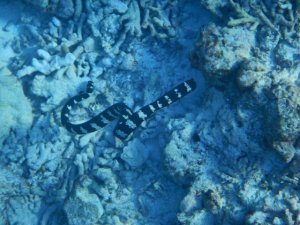Presented By: Ecology and Evolutionary Biology
EEB Tuesday Lunch Seminar: Sensory evolution in the transition from land to sea: how do sea snakes sense their underwater world?
Jenna Crowe-Riddell, U-M EEB Postdoctoral Fellow

Please join us for our weekly brown bag lunch seminar.
Abstract
The senses are our interface with our surrounding world and attuned to specific qualities of prominent signals within the environment. Studying the ways in which senses have changed during evolution can be a marker of how organisms respond to major ecological shifts. Snakes have invaded aquatic habitats multiple times, but, with over 60 fully-aquatic and ecologically diverse species, few groups have been so successful as sea snakes (Elapidae: Hydrophiinae). I will explore the sensory evolution of sea snakes, with emphasis on two senses that are mediated by the skin: mechanoreception (touch) and tail phototaxis (skin photoreception). Tiny mechanoreceptors on the scales of sea snakes have undergone substantial changes during evolution, I will discuss whether these morphological changes are likely to confer a 'hydrodynamic' function (analogous to the lateral line system of fishes) in sea snakes. Light sensitivity of the paddle-tail in sea snakes (tail phototaxis) is a rare trait among vertebrates and convergent with other elongate, aquatic species (hagfish, lamprey, aquatic salamanders). I explore the evolutionary origins, genetic mechanisms and ecological factors underlying this fascinating sense in sea snakes.
Abstract
The senses are our interface with our surrounding world and attuned to specific qualities of prominent signals within the environment. Studying the ways in which senses have changed during evolution can be a marker of how organisms respond to major ecological shifts. Snakes have invaded aquatic habitats multiple times, but, with over 60 fully-aquatic and ecologically diverse species, few groups have been so successful as sea snakes (Elapidae: Hydrophiinae). I will explore the sensory evolution of sea snakes, with emphasis on two senses that are mediated by the skin: mechanoreception (touch) and tail phototaxis (skin photoreception). Tiny mechanoreceptors on the scales of sea snakes have undergone substantial changes during evolution, I will discuss whether these morphological changes are likely to confer a 'hydrodynamic' function (analogous to the lateral line system of fishes) in sea snakes. Light sensitivity of the paddle-tail in sea snakes (tail phototaxis) is a rare trait among vertebrates and convergent with other elongate, aquatic species (hagfish, lamprey, aquatic salamanders). I explore the evolutionary origins, genetic mechanisms and ecological factors underlying this fascinating sense in sea snakes.